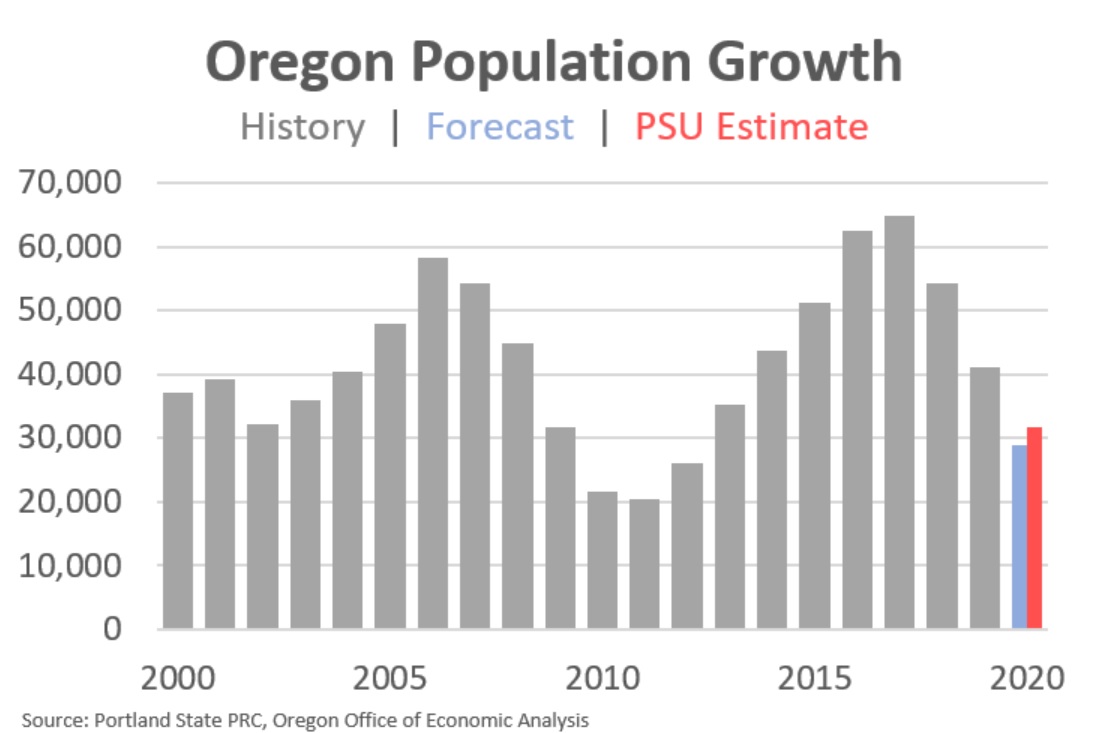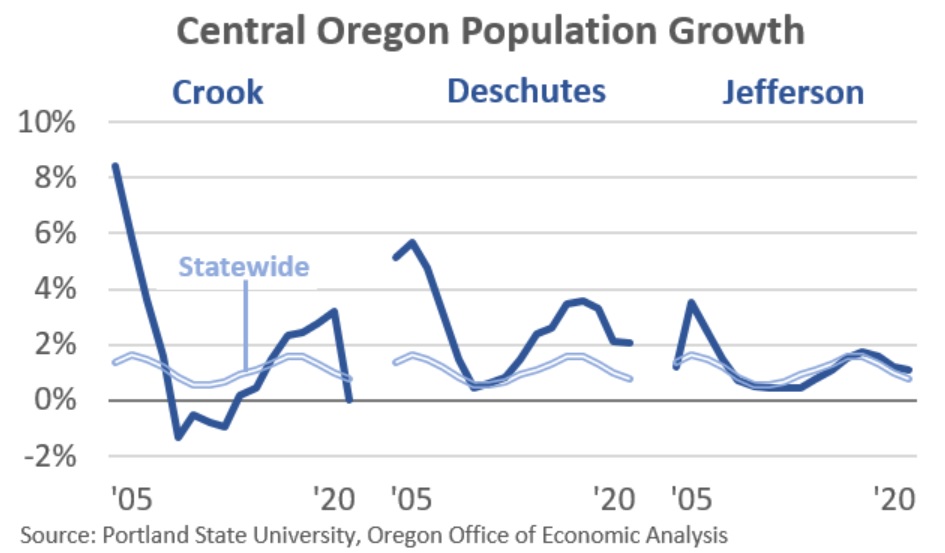
By Josh Lehner,
Office Economic Analysis
Solid data on pandemic migration and working from home has always been years away. Plus we normally see migration slow down during recessions. People tend to follow the jobs, and with fewer job opportunities in a recession, fewer people usually move. Our office has repeatedly tried to highlight these facts and patterns. We have also tried to flag that anything saying otherwise is based on limited, or anecdotal information and usually combined with speculation. It doesn’t mean it is wrong, just that our traditional measures of population growth take time. As such, today I wanted to highlight what we know, and when we will know it. As such, you’re likely going to be disappointed in the content of this post.
Let’s start first with the latest population estimates from our friends at Portland State’s Population Research Center. In 2020, Oregon’s population was 4,268,055 which is an increase of nearly 32,000 compared to 2019. This is the smallest annual increase since 2012 and continues the slowdown seen in recent years. That said, our office’s post-COVID forecast was for an increase of around 29,000, which called for a little bit sharper slowdown due to the pandemic and recession. Keep in mind this is total population growth so while net migration is the vast majority of growth, it does include births and deaths as well.
Now what you need to know here is that Portland State does a mid-year, July 1st estimate. So that means the numbers incorporate everything that happened in the second half of 2019 up through the pandemic and early summer. We know people didn’t move much during the shelter in place phase of the cycle. Furthermore, to the extent the recent boom in home sales represents a pick up in migration, that won’t be reflected until the 2021 estimates are available around next Thanksgiving. It’ll be awhile.
Another complicating factor here is the 2020 Census. That data has been delayed and as far as I can tell Census is saying the numbers will be released as close to Dec 31st, 2020 as possible. That likely means any day or week now. Why this matters is that the decennial census always acts as a demographic anchoring point. Once it is known, demographers will go back and revise the 2011-2019 data — what are called intercensal years — to make sure it all lines up and fits nicely between the 2010 and 2020 Census figures. Additionally Census does April 1st estimates so the number also won’t include any post-shelter in place migration trends.
Now, we will get the 2020 American Community Survey data in September 2021. That’s a continuous survey so will include responses from before, during, and after the shelter in place phase of the cycle. The ACS is the best place to get the characteristics of migrants (age, income, educational attainment, etc). But, again, it’ll be awhile.
With that said, let’s take a closer look at the 2020 estimates from Portland State. Overall, all regions of the state continued to see population growth, lead by the East Cascades and Portland metro regions. Specifically, 31 out of our 36 counties saw increases. This is a pick up from the 27 gaining population a couple of years ago. The population gains in the past decade, while uneven in the sense urban areas are growing faster, have been more broad-based across counties than in recent cycles.
Because we’re all interested in our own areas, here is an update of county level population growth since 2005. The light blue line is the statewide figures while the dark blue line is each individual county. (Central Oregon is a separate set of charts after this big one.)
Central Oregon usually grows significantly faster and is put on a separate chart to better allow for the changes in the y axis. In 2020 the general statewide trends are seen in the Jefferson estimates, while Deschutes growth holds steady and does not decelerate. One of the largest changes in growth from 2019 to 2020 is the sharp slowdown in Crook, going from around 3% in recent years to 0% in 2020. Given the strong home sales numbers, and historical patterns, I would expect Crook population growth to pick back up in the 2021 and onward data.
All told, population growth slowed through mid-2020. This was expected due to the pandemic and ensuring recession. The latest population estimates indicate this slowdown was note quite as sharp as our office forecasted. To the extent migration has picked back up in recent months it will show up in the 2021 population estimates which will be released late this year. Our office has started developing our next forecast, due out in late February.
Disclaimer: Articles featured on Oregon Report are the creation, responsibility and opinion of the authoring individual or organization which is featured at the top of every article.





